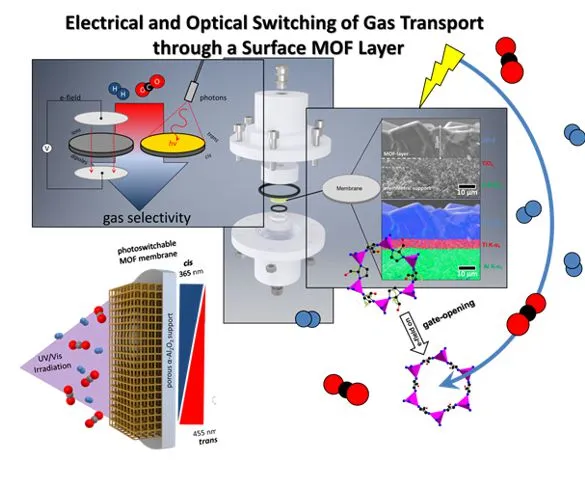| Consortium: | Prof. Dr. Jürgen Caro, Hannover Leibniz Universität Hannover Institute of Physical Chemistry and Electrochemistry |
| Project: | Electrical and Optical Switching of the Gas Transport through SURMOF Membrane Layers |
| Abstract: | Aim of the project is the development of switchable gas selective SURMOF membranes. It is planned to switch by using external stimuli like (electric fields, or (ii) light both the amount of gas streaming through the membranes as well as its composition. The fundamental idea of the project is to exploit the framework flexibility of MOFs as “soft porous materials”. It will be tried to bring the SURMOF layer by these external stimuli into states with different gas transport properties. We have got fundamental knowledge on the molecular mechanisms how the SURMOF lattice is addressed by the external stimuli electric fields and light and how these interactions can be used to modify in a reversible and controlled way the gas transport through the SURMOF layer [1]. The results are documented by publications in Science, Nature Commun. … and 2 patents. (i) Electric Switching [2,3]: By applying an electric field of 500 V/mm to a ZIF-8-SURMOF layer we could modulate both (a) the amount of gas, and (b) its composition (selectivity of the membrane). The electric field addresses the dipolar linkers (methylimidazolate) as well as the ions (Zn2+) of the ZIF-8 structure. The lattice structure of ZIF-8 becomes distorted and stiffened. The stiffened structure shows a reduced gas transport ability. Different crystallographic polymorphs cold be identified in the switched state. The switching was reversible. (ii) Optical Switching [4-7]: Using Liquid Phase Epitaxy we prepared Pillared-Layer SURMOFs which con-tain azobenzene groups as side groups in their linkers. Light of certain wave-length could switch reversibly the azo groups between trans and cis. Depending on the trans or cis state of the SURMOF membrane, the amount of gas and its composition (selectivity) could by controlled. Further results - not directly connected to the switching - have been obtained by A. Knebel (the PhD student financed by the project) to characterize the materi-als under study and published in good journals like Angewandte [8-11]. A. Knebel has defended his PhD after 2.5 years in June 2018 with the highest de-gree “Distinction”. |
| Publications: | [1] A. Knebel, C. Zhou, A. Huang, J. Zhang, L. Kustov, J. Caro, “Smart metal-organic frameworks (MOFs): Switching gas permeation through MOF membranes by external stimuli”, Chem. Eng. Technol. 2018,41, 224-234. DOI: 10.1002/ceat.201700635 |
| [2] A. Knebel, B. Geppert, K. Voglmann, D. I. Kolokolov, A. G. Stepanov, J. Twie-fel, P. Heitsjans, D. Volkmer, J. Caro, "Defibrillation of soft porous metal-organic frameworks with electric fields", Science 2017,356 (6361), 347-351. DOI: 10.1126/science.aal2456 | |
| [3] A. Knebel, J. Caro, “Device and process for controlled gas transport on metal-organic frame-work membranes”, EP162179033.2, filed on 27. June 2017. | |
| [4] Z. Wang, A. Knebel, S. Grosjean, D. Wagner, S. Bräse, C. Wöll, J. Caro, L. Heinke, "Tunable Molecular Separation by Nanoporous Membranes", Nature Communications 2016,7, 13872. DOI: | |
| [5] A. Knebel, L. Sundermann, A. Mohmeyer, S. Friebe, P. Behrens, J. Caro, "Azobenzene Guest Molecules as Light-Switchable CO2 Valves in an Ul-trathin UiO-67 Membrane", Chemistry of Materials 2017,29, 3111-3117. DOI: 10.1021/acs.chemmater.7b00147 | |
| [6] K. Müller, A. Knebel, F. Zhao, D. Bleger, J. Caro, L. Heinke, “Switching thin films of azobenzene-containing metal-organic frameworks with visible light”, Chem. Eur. J. 2017,23, 5434-5438. DOI: 10.1002/chem.201700989 | |
| [7] J. Caro, A. Knebel, L. Heinke, S. Grosjean, C. Wöll, Z. Wang, S. Bräse, “Photo-switching and tuning of gas transport through metal-organic framework membranes”, EP16192873.4, filed on 7. October 2016 | |
| [8] A. Knebel, P. Wulfert-Holzmann, S. Friebe, J. Pavel, I. Strauß, A. Mundstock, F. Steinbach, J. Caro, “Hierarchical nanostructures of metal-organic frameworks applied in gas separating ZIF-8-on-ZIF-67 membranes”, Chem. Eur. J. 2017,24, 5728-5733. DOI: 10.1002/chem.201705562 | |
| [9] I. Strauß, A. Mundstock, D. Hinrichs, R. Himstedt, A. Knebel, C. Reinhardt, D. Dorfs, J. Caro, “The interaction of guest molecules with Co-MOF-74: A Vis/NIR and Ra-man approach”, Angew. Chem. Int. Ed. 2018,57, 7434-7439. DOI: 10.1002/anie.201801966 | |
| [10] H. Fan, J. Gu, H. Meng, A. Knebel, J. Caro, “High-flux membranes based on the covalent organic framework COF LZU1 for selective dye separation by nanofiltration”, Angew. Chem. Int. Ed. 2018,57, 4083-4087. DOI: 10.1002/anie.201712816 | |
| [11] A. Knebel, S. Friebe, N.C. Bigall, M. Benzaqui, C. Serre, J. Caro, “Comparative, Study of MIL-96(Al) as Continuous MOF-Layer and Mixed-Matrix-Membrane”, ACS Applied Materials and Interfaces 2016,8, 7536-7544. DOI: 10.1021/acsami.5b12541 | |
